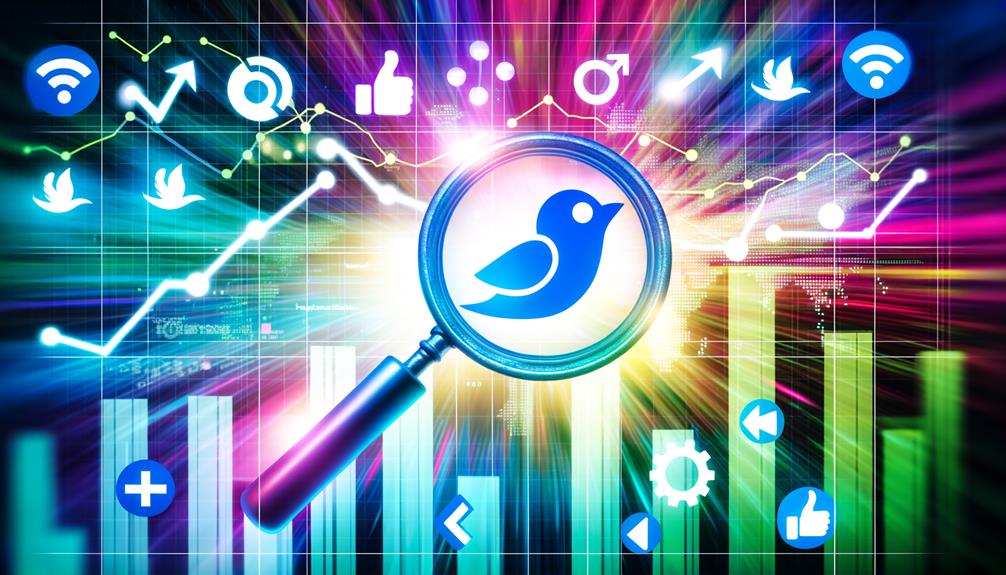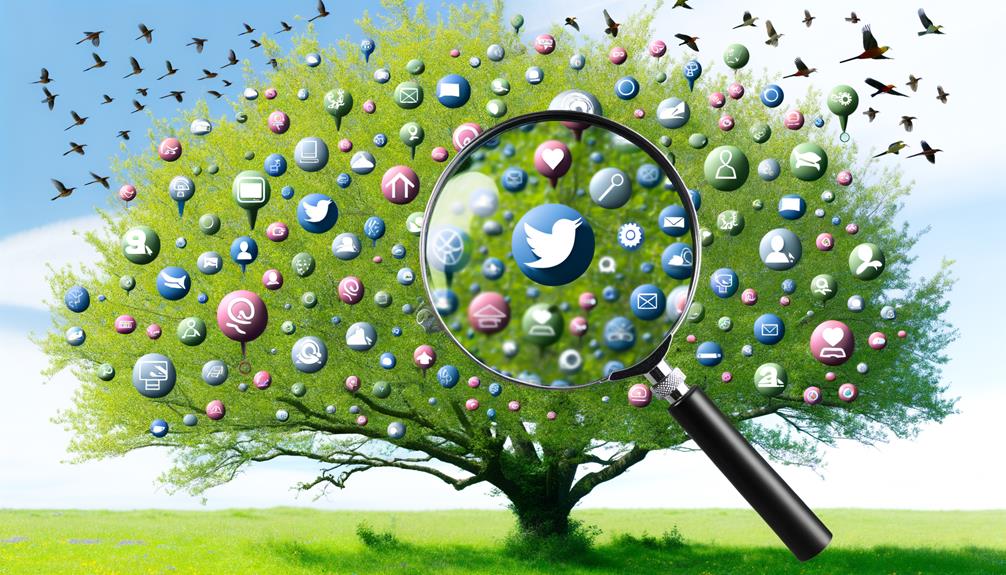No products in the cart.
Navigating Twitter’s vast ocean of content without analytics is like setting sail without a compass; you might move forward, but you’re unlikely to reach your destination efficiently. You’ve likely experienced the frustration of tweets that vanish into the void, receiving little to no engagement.
This common challenge underscores the importance of refining your Twitter content strategy with precise analytics. By understanding the seven key strategies—from identifying crucial metrics to continuous testing—you’ll not only steer your content towards greater visibility and engagement but also unlock insights that could transform your approach.
Let’s explore how these strategies can serve as your compass, guiding you towards more impactful interactions on Twitter.
Key Takeaways
- Utilize Twitter Analytics to identify peak engagement times and optimize your posting schedule.
- Analyze top-performing tweets to understand audience preferences and improve content relevancy.
- Leverage visual content like images and videos to significantly boost engagement rates.
- Implement A/B Testing to refine engagement strategies and content effectiveness continuously.
Identify Key Metrics
Analyzing key metrics, such as engagement rates, conversion rates, and follower growth, is crucial to refining your Twitter content strategy effectively. You’re in a dynamic digital arena, where understanding engagement trends and audience demographics isn’t just helpful—it’s essential. By diving into the data, you unlock insights that guide your content’s direction, ensuring it resonates with your audience.
Content effectiveness shines through when you closely monitor likes, retweets, and replies. These interactions aren’t just numbers; they’re a reflection of how compelling your content is. Is it sparking conversation? Is it share-worthy? These are the questions that your engagement metrics answer, offering a clear path to fine-tuning your messaging for maximum impact.
Conversion tracking takes this a step further by bridging the gap between engagement and action. It’s one thing for your content to be liked; it’s another for it to drive tangible results. By analyzing conversion rates from your Twitter campaigns, you’re not just guessing at content effectiveness—you’re measuring it. This data-driven approach ensures that every tweet, every campaign, is an opportunity to learn, adapt, and innovate, keeping your strategy ahead of the curve.
Analyze Audience Engagement
To truly grasp how your audience interacts with your content, you’ll need to measure engagement rates closely, identifying which posts resonate most.
By segmenting audience interactions, you can pinpoint the specific content that sparks the most conversation and drives action.
This strategy not only reveals what captures your audience’s attention but also empowers you to refine your content approach for optimal engagement.
Measuring Engagement Rates
Diving into measuring engagement rates can unlock insights into how your audience interacts with your content on Twitter. By engaging with replies, retweets, and likes, you’ll get a clear picture of your audience’s interest. But don’t stop there. Tracking link and hashtag clicks can deepen your understanding of how your content resonates. Monitoring follower growth and interaction patterns offers a broader view of engagement trends.
Sentiment analysis and tracking engagement benchmarks are crucial for content optimization. Calculate the engagement rate per Tweet to see what’s working. Use Twitter Analytics for a detailed look at your metrics, guiding your strategy with data-driven decisions. Remember, it’s about understanding and adapting to your audience’s preferences for maximum impact.
Identifying Popular Content
After gauging your audience’s interaction through engagement rates, it’s crucial you pinpoint the content that truly resonates by examining likes, retweets, and replies. Delve into the analytics to discover not just what’s catching their eye, but what makes them click, share, and engage.
- Analyze top-performing tweets for engagement trends, focusing on likes, retweets, and replies.
- Observe patterns in these metrics to uncover popular themes and audience preferences.
- Track click-through rates on shared links for a direct measure of content effectiveness.
- Prioritize multimedia content, as videos and images often boast higher engagement rates.
Leveraging these insights will enable you to craft content that not only captivates but also connects with your audience, driving your Twitter strategy towards success.
Segmenting Audience Interactions
Understanding your audience’s unique behaviors and preferences is key to segmenting their interactions effectively, enabling you to tailor your Twitter content with precision. By diving into demographics, interests, and behavior, you’re not just guessing; you’re applying a strategic approach to content customization.
Analyzing engagement metrics like likes, retweets, and replies reveals not just who’s interacting but how they’re engaging, unlocking insights into engagement trends that are invaluable for demographic targeting.
Leveraging Twitter Analytics, you can pinpoint peak engagement times, optimizing your content scheduling to ensure maximum visibility. This data-driven methodology allows you to measure the impact of various content types, refining your strategy to boost both engagement and conversions.
It’s about making informed decisions that resonate with your audience, turning insights into action.
Optimize Posting Schedule
To optimize your Twitter strategy, it’s crucial you analyze peak engagement times, evaluating which content types resonate most during these windows.
Understanding the frequency’s impact on reach allows you to tailor your posting schedule, ensuring your tweets hit the mark when your audience is most receptive.
This approach not only boosts visibility but significantly enhances interaction with your content.
Analyze Peak Engagement Times
Diving into Twitter Analytics reveals the best times to post by highlighting when your audience is most engaged. Understanding engagement patterns across different time zones and monitoring audience activity helps tailor your posting frequency, ensuring your tweets land at just the right moment.
- Engagement patterns: Identify when your followers are most interactive.
- Time zones: Adjust posting times to cater to followers across the globe.
- Audience activity: Monitor when your community is scrolling through their feeds.
- Posting frequency: Experiment with different schedules to find the sweet spot.
Analyzing these aspects leads to a refined content calendar, aligning your tweets with peak engagement times. This strategic approach not only boosts visibility but also fosters a deeper connection with your audience.
Content Type Performance Evaluation
After analyzing peak engagement times, it’s crucial to delve into how different content types perform on Twitter to fine-tune your posting schedule for the highest engagement. By leveraging Twitter Analytics, you’ll uncover not just when your audience is online, but what they prefer to engage with.
Whether it’s videos, images, or links, each content type has its own set of engagement trends and click-through rates that reveal your audience’s content preferences. Identifying these patterns allows you to schedule posts strategically, ensuring each tweet lands when it’s most likely to captivate and resonate.
This data-driven approach not only optimizes your content mix but aligns it perfectly with the times your audience is most receptive, significantly boosting your engagement rates.
Frequency Impact on Reach
Understanding the impact of posting frequency on your Twitter reach is crucial for optimizing your schedule and maximizing engagement. By aligning your strategy with audience behavior and engagement patterns, you can significantly enhance your Twitter presence.
- Posting consistency: Aim for at least once per day to maintain visibility and keep your audience engaged.
- Peak activity: Schedule your tweets between Tuesday and Friday, 9 AM to noon, to capitalize on higher user activity.
- Utilize tools: Employ Sprout’s ViralPost™ to find optimal posting times tailored to your followers.
- Content calendar: Keep a steady stream of tweets with a content calendar, ensuring consistent reach and impact.
This approach, grounded in data, lets you navigate the complexities of peak activity and posting consistency, setting you on the path to increased Twitter engagement.
Leverage Hashtag Performance
To effectively boost your brand’s online visibility and engagement, it’s crucial to leverage hashtag performance by utilizing trending and branded hashtags. Hashtags not only increase message association by 18% but also amplify brand awareness by 8%. When you tap into hashtag trends, you’re positioning your content to be discovered by a wider, yet targeted, audience. This strategy can directly influence your engagement rates and, in turn, potentially lift purchase intent by 3%.
Utilizing Twitter Analytics for hashtag analysis is a game-changer. It allows you to monitor which hashtags resonate most with your audience, enabling you to optimize your content strategy continuously. Remember, it’s not just about jumping on every trending hashtag but finding those that align with your brand’s voice and objectives.
| Hashtag Type | Benefits |
|---|---|
| Trending | Increases visibility and engagement |
| Branded | Encourages user-generated content |
| Analyzed | Optimizes content strategy |
| Engagement | Lifts brand awareness |
| Purchase Intent | Boosts potential sales |
Monitor Competitor Strategies
While you refine your hashtag strategy, it’s also crucial to keep an eye on how competitors are navigating their Twitter content to carve out an edge in audience engagement. Competitive analysis isn’t just about keeping tabs; it’s about turning insights into action. Understanding the landscape can help you identify opportunities for innovation and strategic partnerships, especially when it comes to influencer collaborations.
To stay ahead, consider these key points:
- Analyze tweet frequency and engagement: How often are your rivals posting, and what kind of interaction are they getting? This can give you a benchmark for your own content strategy.
- Spot influencer partnerships: Are competitors teaming up with influencers? See how these partnerships are working out for them and think about how you could adopt a similar, yet unique approach.
- Monitor hashtag and multimedia use: Which hashtags are they leveraging, and how are they incorporating visuals and videos? This could inspire your content diversification.
- Track response rates: How quickly and effectively are they engaging with their audience? It’s essential for gauging their customer service and engagement levels.
Leveraging these insights allows you to fine-tune your strategy, ensuring you’re not just keeping up but setting the pace.
Utilize Visual Content Insights
Leveraging the power of visual content on Twitter can significantly amplify your engagement rates, as tweets with images or videos generate far more interaction than text-only posts. With visual content generating 150% more retweets and images alone seeing an 18% increase in clicks, it’s clear that incorporating visuals into your Twitter strategy isn’t just beneficial—it’s essential.
Videos, in particular, are a goldmine for engagement, driving 10x more interaction compared to static images and capturing the attention of the 82% of Twitter users who watch video content on the platform.
To stay ahead, you need to tap into visual marketing trends and keep a keen eye on content performance tracking. Infographics and GIFs, known for their high shareability, can play a pivotal role in your content mix, providing value and entertainment in a concise format. By analyzing which types of visual content resonate most with your audience, you can refine your strategy to include more of what works. Remember, it’s not just about posting visuals—it’s about posting the right visuals that engage and captivate your audience.
Implement Continuous Testing
After harnessing the power of visual content for greater engagement, it’s crucial you now implement continuous testing to refine your Twitter strategy further. By leveraging real-time data, you’re not just guessing what works; you’re applying a scientific approach to enhance your content’s effectiveness. Continuous testing, including A/B testing, enables you to understand precisely how different tweet formats, timings, and content types perform among your audience.
Here’s why you should dive into continuous testing:
- A/B Testing: Compare different strategies to see which yields better engagement metrics, such as likes, retweets, and replies.
- Engagement Metrics Analysis: Measure the effectiveness of your content by observing real-time engagement and adjusting your strategy accordingly.
- Audience Demographics: Tailor your content to fit your audience’s preferences by analyzing follower growth and demographics.
- Time Optimization: Identify the best times to post by testing different schedules, ensuring your tweets reach the maximum audience.
Frequently Asked Questions
What Is the 80 20 Rule on Twitter?
The 80/20 rule on Twitter, inspired by Pareto Principle basics, suggests you’ll see better engagement by making 80% of your tweets valuable and just 20% promotional. It’s a proven tactic to boost your follower interaction.
What Makes a Good Twitter Strategy?
A good Twitter strategy hinges on audience engagement and profile optimization. You’ll want to analyze data to innovate and keep content fresh. Engage directly, optimize regularly, and watch your strategy drive real, measurable results.
What Type Content Is Most Successful on Twitter?
On Twitter, you’ll find visual content like videos and images outshine text-only posts, driving significantly more engagement. Timing your tweets can further boost their success, making strategic scheduling key to capturing your audience’s attention.
How to Get 5 Million Impressions on Twitter?
To hit 5 million impressions on Twitter, dive into hashtag research to find trending topics. Post when your audience is most active for peak engagement. It’s about timing and tapping into the conversation effectively.
Conclusion
In conclusion, mastering your Twitter content strategy is all about diving deep into the analytics. You’ve got to keep an eye on key metrics, understand how your audience engages, and tweak your posting schedule for maximum impact.
Don’t forget to harness the power of hashtags, keep tabs on competitors, and make your visuals pop. Above all, continuous testing is your best friend. By making data-driven decisions, you’ll not only boost engagement but also achieve your business goals.
Stay analytical, stay engaged, and watch your Twitter presence soar.






